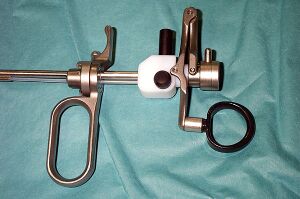Transurethral resection of the bladder
Transurethral (bladder) resection, or TUR , is a surgical method used in the diagnosis and treatment of bladder cancer. Another abbreviation used is TURB or TURBT (transurethral resection of bladder tumor). It is the method of choice in the treatment of non-invasive bladder tumors. An alternative to the procedure is laser evaporation of the tumor, but this lacks the possibility of histological verification.
Method Objectives[edit | edit source]
- Diagnostics – histological verification of suspected deposits in the bladder wall, TNM tumor classification , verification of interstitial cystitis
- Therapy – resection of suspicious foci, primary or recurrent tumor.
Execution[edit | edit source]
The procedure is performed under both general and spinal anesthesia. It proceeds through the urethra under visual control (on the screen), when suspicious deposits are cut out of the bladder wall with a resection loop (resectoscope). The bottom of the resection area is then coagulated, which stops the bleeding and eliminates any remaining tumor cells. Finally, the bladder is flushed of blood, coagulum and excised tissue, and a permanent urinary catheter (PMC) is inserted after the procedure. Tissue samples from the lavage are then sent for histological examination. Thanks to the introduced blood vessel, it is possible to control postoperative bleeding. At the same time, the tube serves to prevent blockage of the urethra with coagulum and is left for a period depending on the extent and depth of the resection, usually 1-3 days until the bleeding subsides.
- After induction of anesthesia, before the procedure itself, a bimanual examination of the small pelvis is recommended . The index finger of one hand is introduced into the anus (in women, into the vagina), the other hand palpates suprapubically. The occurrence of resistance is often associated with the presence of an invasive tumor. After assessing its consistency, mobility and size, an experienced doctor can estimate the radicality of the procedure, or consider a cystectomy.
- For larger tumors, TUR is performed fractionally, i.e., the macroscopically clear tumor tissue is resected first, and then the underlying tissue. Each sample is then sent for histological examination separately.
Possible complications[edit | edit source]
- Haematuria – with retained PMK, its disappearance usually occurs soon after the procedure. In the case of massive hematuria, bladder tamponade is possible (when flushing from coagulum is necessary), and in the case of a decrease in red blood cells, replacement with blood derivatives is also necessary.
- Urinary tract infection (24%)[1] – – cured with ATB
- Urgency – usually after pulling out the PMK, takes antispasmodic therapy. It can also be a symptom of the aforementioned urinary tract infection.
- Urinary incontinence – after PMK extraction.
- Bladder wall perforation (5%) – most often during resection in the vertex area. If the perforation is extraperitoneal, it is solved by leaving the PMK for 5-7 days. If it is intraperitoneal, an open revision of the abdominal cavity with suturing of the perforation itself is appropriate.
- Stricture of the ureter – during resection in the area of the intramural ureter, it is caused by scarring.
- Embolism - prevention is the administration of LMWH before the procedure, possibly also in the postoperative period.
- TUR syndrome (exceptionally) – consequences of hypervolemia from absorption of irrigation fluid by the resection base.
Forecast[edit | edit source]
- Five-year survival after TUR is 75-90% for non-invasive cancers
- Even after TUR, recurrences of the tumor often occur, so the procedure often has to be repeated (so-called re-TUR ).
- In some cases, patients after TUR undergo chemotherapy or immunotherapy (so-called adjuvant intravesical therapy)
Links[edit | edit source]
Related Articles[edit | edit source]
Literature[edit | edit source]
- KAWACIUK, Ivan. Urologie. 1. edition. Praha : Galén, c2009. ISBN 978-80-7262-627-7.
- DVOŘÁČEK, Jan – BABJUK, Marko, et al. Onkourologie. 1. edition. Praha : Galén : Karolinum, c2005. ISBN 80-246-1108-2.
- HEALTHWISE, Incorporated. Transurethral Resection (TUR) for Bladder Cancer [online]. [cit. 2013-11-30]. <https://www.webmd.com/cancer/bladder-cancer/tur-surgery-facts>.
Reference[edit | edit source]
- ↑ KAWACIUK, Ivan. Urologie. 1. edition. Praha : Galén, c2009. ISBN 978-80-7262-627-7.


